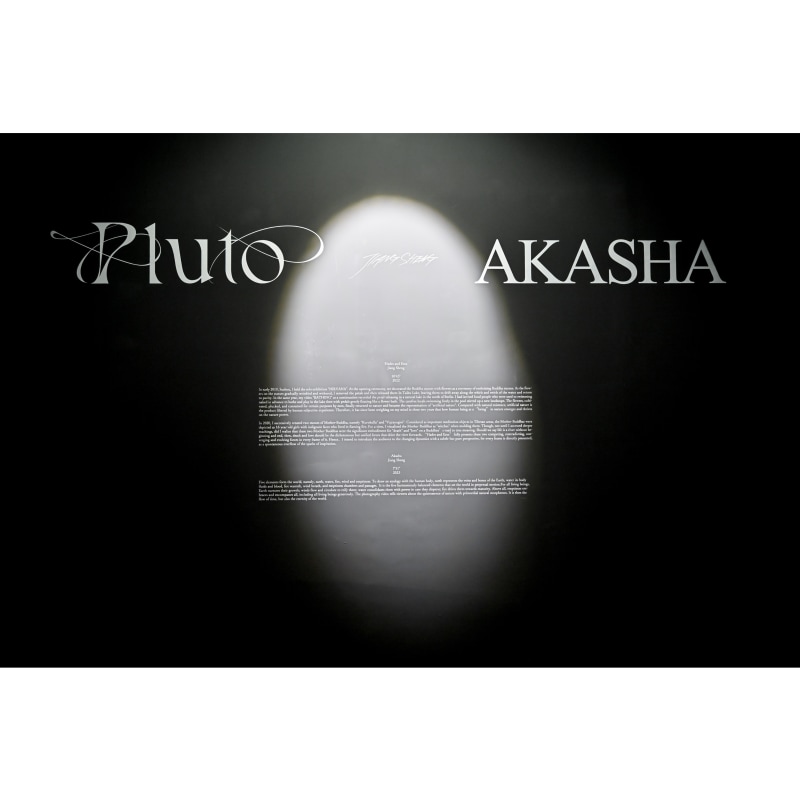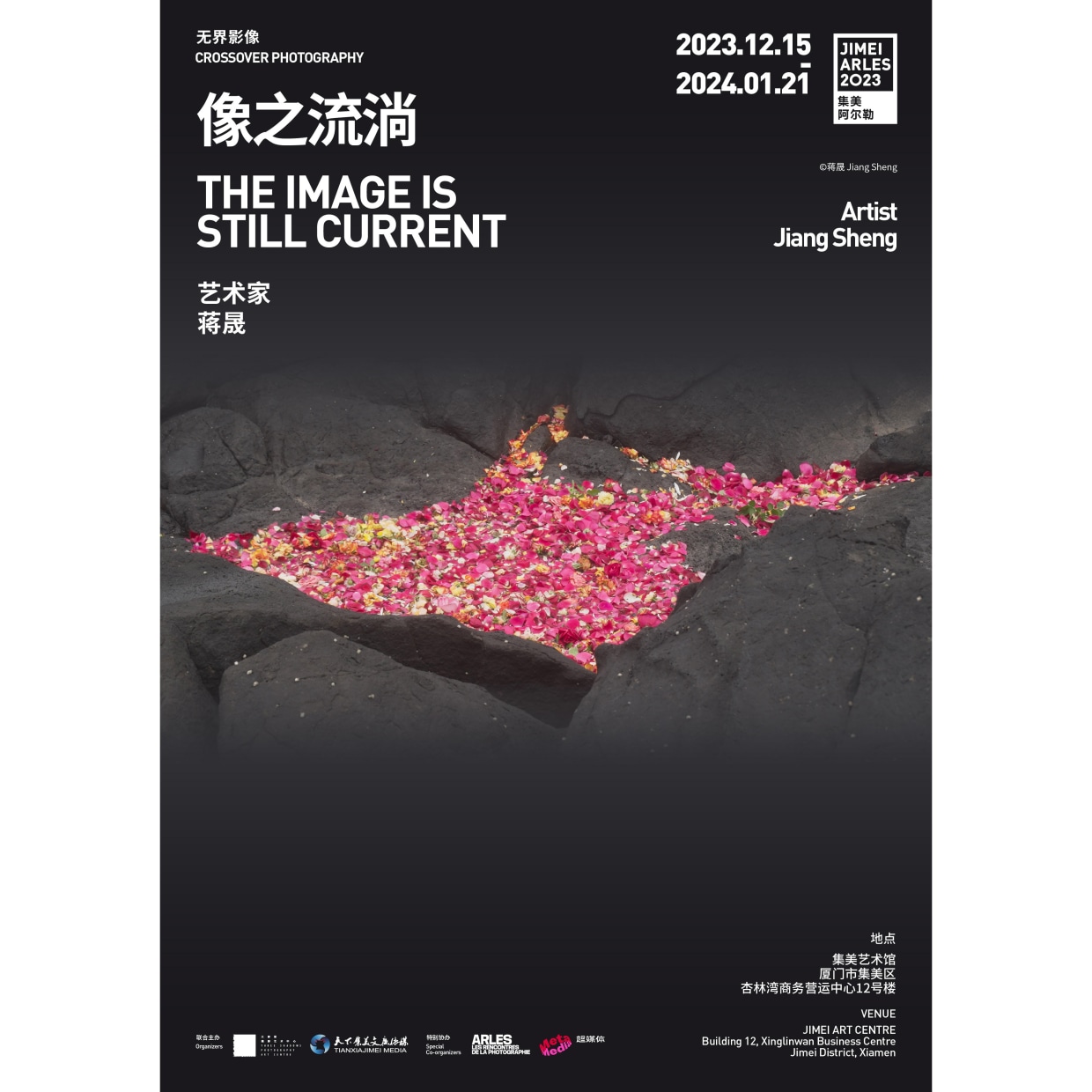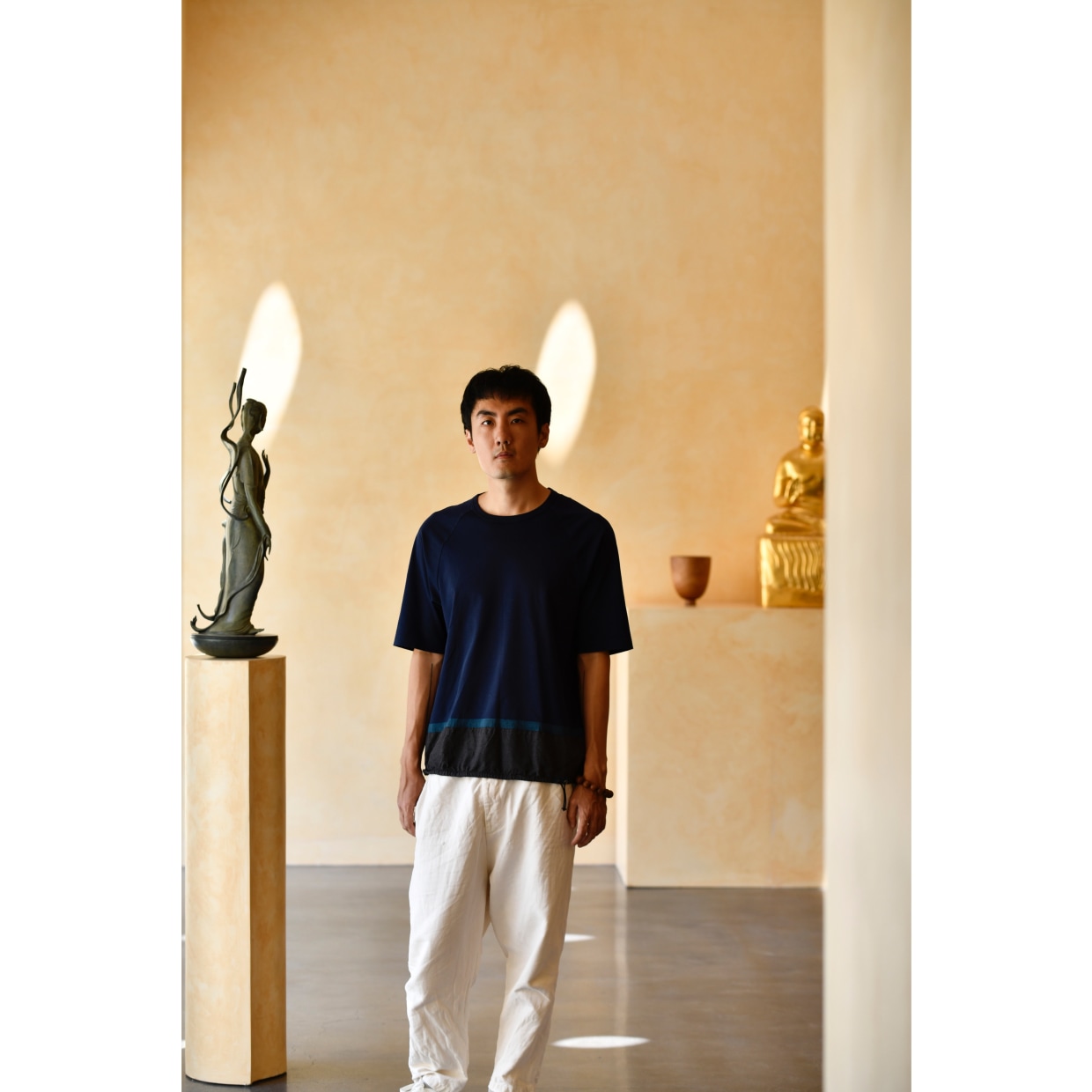In 2022, the Buddhist sculptor Jiang Sheng crafted two video works, Hades and Eros and AKASHA.
Hades and Eros is inspired by the Buddhist practice which one disperses and releases the offering flowers after the service. Fresh flowers serve as a bridge between humans and Buddhist deities. In early 2019, Jiang Sheng showcased a solo exhibition titled "Inflorescence" at the Hanshan Art Museum in Suzhou. During the opening, Jiang Sheng and his friends offered floral tributes to the Buddhist statues. While the petals previously offered to the gods started to fade, the symbolic act of dispersal commenced therein.
As real-life recounts blurs with constructed scenes, flowers that once adorned the statues now drift uninhibited through streams, leaving their silhouette behind. The flowers gather in the shallows, and later become enveloped by the flames. As the fire dances fluidly among the petals, the fume halfly veils a floral-decorated red statue — Jiang Sheng's tin-bronze depiction of Kurukullā from 2020.
In Tibetan Buddhism, Kurukullā is seen as a goddess of power, and she is also the Tantric Buddhist deity in charge of authority and dharma. After extensive casting and engraving, this statue brings to life Kurukullā's dharmic form, said to be "having a body of a sixteen-year-old girl, entirely red, representing the method of love." Her golden hair rises fiercely, crowned with five skulls. With a wrathful expression, she subdues the four demons. She is wrapped by roaring flames, and her vastness expands amidst compassion, loving-kindness, joy, and equanimity. The burned flowers release fume under her gaze which encompasses both love and death.
Hades and Eros extends Jiang Sheng's reflections on the interplay between human life, the natural world, and the environments shaped by human hands. He noted that these flowers, soaked in water, owe their cultivation and harvest to human actions. Once these flowers have served the purpose humans set for them, they are released back to nature, illustrating a cycle of "human-influenced nature." This artwork prompts us to ponder certain questions, for instance, how do humans, a part of the natural world, rely on its forces for survival? If life is likened to a river's flow, where might death and love take us?
Hades and Eros delicately explores the paralleling imagery embedded in both the Buddhist statues and the film. Flowers once adorned the Buddhist statues, now flow downstream, finding solace in the embodiment of another Buddhist deity. This narrative of the Buddha's "presence" and "absence" weaves seamlessly into the five elements depicted in AKASHA.
In Buddhist teachings, the world is composed of five primary elements: earth, water, fire, wind, and void. Earth, water, fire, and wind account for all tangible matters and are collectively known as the Four Realms. Drawing from the philosophical foundations of ancient Indian religions, void was introduced as the fifth element. Within the imagery, each of these elements accords with a specific color: yellow for earth, green for water, red for fire, and clear blue gaze for both wind and void, with void also being colorless.
In the Mundaka Upanishad, ancient Indian sages utilize an anthropomorphic analogy to elucidate the concept of "Brahma."[1] Brahma gives rises to the self-origin of all worldly entities. As the ultimate truth, Brahma not only gives birth to all beings but also instills stillness into them. It's simultaneously dynamic and still, both intimate and remote.
Drawing a parallel with the human body in relation to these five elements: earth symbolizes the body structure and bones; water, its fluids, and blood; fire, its warmth; wind, the rhythm of breath and circulation of air; and void denotes the body's internal pathways and channels.
AKASHA obscures the tangible body and uses the five elements to depict the world's five qualities: Earth is the foundation for all things to grow, the circulation of wind gives shape to all things based on this foundation, water provides the power to integrate and to prevent dispersion, fire grants maturity, spurring the growth of all. Space encompasses everything, accommodating all phenomena.
Guided by the drone's perspective, we're privy to the continuous renewal of life spirit and ever-changing landscapes. Every shot captivates with the Earth's rich topographic features and their hues–a ceaseless wonder for the eyes that seems to echo in our very being, aligning with a meditative heart's rhythm. Its title, "AKASHA", often translated into “the realm of space" from Sanskrit, can also denote perceiving through one's awareness of a unified energy field.
Jiang Sheng once spoke of a "presence from that time." He observed that sometimes, even after monks have departed, the atmosphere of their previous presence still lingers in the temple space. Hades and Eros and AKASHA are showcased in their original split-screen format at the Jimei x Arles International Photo Festival. These two intertextual pieces are positioned at a specific angle to each other, with the hope that viewers within the space can also sense the flow of images between the "here and now" and the "there and then."
[1] From the Mundaka Upanishad: "His head is fire, his eyes are the moon and the sun, his ears are the directions, his speech is the revealed Vedas, his breath is the wind, his heart is the universe, his feet give rise to the Earth, Brahma is the inner self of all beings."




 Portrait of Jiang Sheng
Portrait of Jiang Sheng Jiang Sheng, Stills from the video “Hades and Eros”, 2022. Courtesy of the artist.
Jiang Sheng, Stills from the video “Hades and Eros”, 2022. Courtesy of the artist. Jiang Sheng, Stills from the video “Hades and Eros", 2022. Courtesy of the artist.
Jiang Sheng, Stills from the video “Hades and Eros", 2022. Courtesy of the artist. Jiang Sheng, Stills from the video “Hades and Eros", 2022. Courtesy of the artist.
Jiang Sheng, Stills from the video “Hades and Eros", 2022. Courtesy of the artist. Jiang Sheng, Stills from the video “Hades and Eros", 2022. Courtesy of the artist.
Jiang Sheng, Stills from the video “Hades and Eros", 2022. Courtesy of the artist. Jiang Sheng, Stills from the video “Hades and Eros", 2022. Courtesy of the artist.
Jiang Sheng, Stills from the video “Hades and Eros", 2022. Courtesy of the artist. Jiang Sheng, Stills from the video “AKASHA", 2022. Courtesy of the artist.
Jiang Sheng, Stills from the video “AKASHA", 2022. Courtesy of the artist. Jiang Sheng, Stills from the video “AKASHA", 2022. Courtesy of the artist.
Jiang Sheng, Stills from the video “AKASHA", 2022. Courtesy of the artist. Jiang Sheng, Stills from the video “AKASHA", 2022. Courtesy of the artist.
Jiang Sheng, Stills from the video “AKASHA", 2022. Courtesy of the artist. Jiang Sheng, Stills from the video “AKASHA”, 2022. Courtesy of the artist.
Jiang Sheng, Stills from the video “AKASHA”, 2022. Courtesy of the artist. Jiang Sheng, Stills from the video “AKASHA”, 2022. Courtesy of the artist.
Jiang Sheng, Stills from the video “AKASHA”, 2022. Courtesy of the artist.